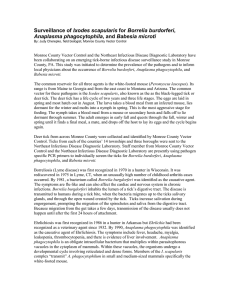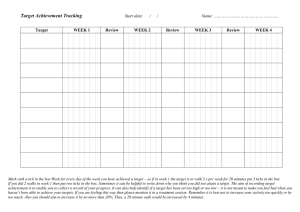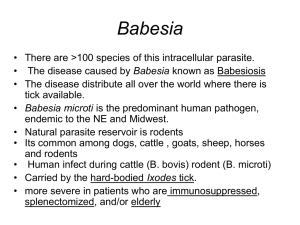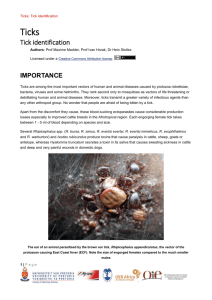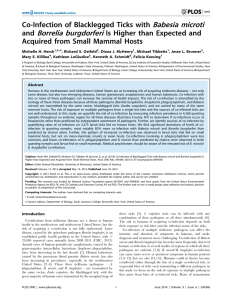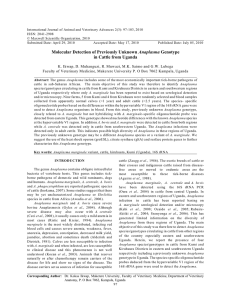Are Abundances of Diseases in Local Deer Ticks Changing? Discussion Introduction
advertisement
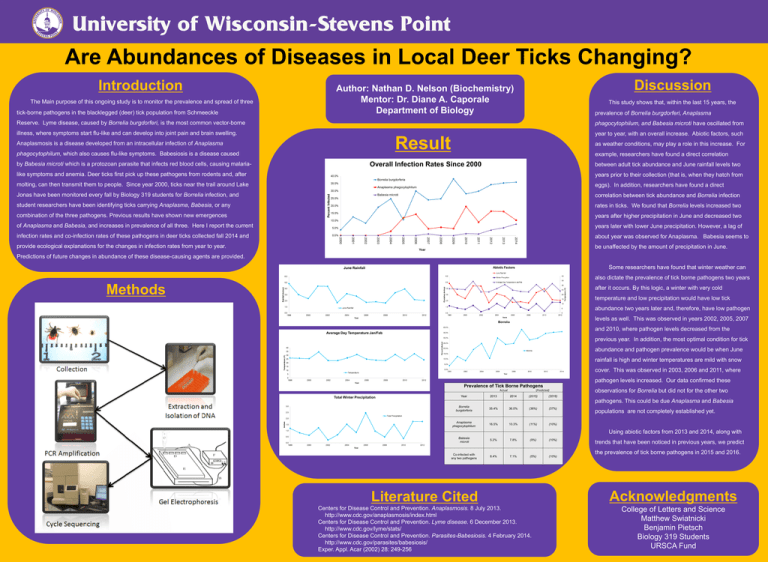
Are Abundances of Diseases in Local Deer Ticks Changing? Introduction The Main purpose of this ongoing study is to monitor the prevalence and spread of three tick-borne pathogens in the blacklegged (deer) tick population from Schmeeckle Discussion Author: Nathan D. Nelson (Biochemistry) Mentor: Dr. Diane A. Caporale Department of Biology This study shows that, within the last 15 years, the prevalence of Borrelia burgdorferi, Anaplasma Reserve. Lyme disease, caused by Borrelia burgdorferi, is the most common vector-borne phagocytophilum, and Babesia microti have oscillated from illness, where symptoms start flu-like and can develop into joint pain and brain swelling. year to year, with an overall increase. Abiotic factors, such Anaplasmosis is a disease developed from an intracellular infection of Anaplasma phagocytophilum, which also causes flu-like symptoms. Babesiosis is a disease caused by Babesia microti which is a protozoan parasite that infects red blood cells, causing malarialike symptoms and anemia. Deer ticks first pick up these pathogens from rodents and, after Result s as weather conditions, may play a role in this increase. For example, researchers have found a direct correlation between adult tick abundance and June rainfall levels two years prior to their collection (that is, when they hatch from molting, can then transmit them to people. Since year 2000, ticks near the trail around Lake eggs). In addition, researchers have found a direct Jonas have been monitored every fall by Biology 319 students for Borrelia infection, and correlation between tick abundance and Borrelia infection student researchers have been identifying ticks carrying Anaplasma, Babesia, or any rates in ticks. We found that Borrelia levels increased two combination of the three pathogens. Previous results have shown new emergences years after higher precipitation in June and decreased two of Anaplasma and Babesia, and increases in prevalence of all three. Here I report the current years later with lower June precipitation. However, a lag of infection rates and co-infection rates of these pathogens in deer ticks collected fall 2014 and about year was observed for Anaplasma. Babesia seems to provide ecological explanations for the changes in infection rates from year to year. be unaffected by the amount of precipitation in June. Predictions of future changes in abundance of these disease-causing agents are provided. Some researchers have found that winter weather can also dictate the prevalence of tick borne pathogens two years Methods after it occurs. By this logic, a winter with very cold temperature and low precipitation would have low tick abundance two years later and, therefore, have low pathogen levels as well. This was observed in years 2002, 2005, 2007 and 2010, where pathogen levels decreased from the previous year. In addition, the most optimal condition for tick abundance and pathogen prevalence would be when June rainfall is high and winter temperatures are mild with snow cover. This was observed in 2003, 2006 and 2011, where pathogen levels increased. Our data confirmed these Prevalence of Tick Borne Pathogens Actual Year 2013 (Predicted) 2014 (2015) observations for Borrelia but did not for the other two (2016) pathogens. This could be due Anaplasma and Babesia Borrelia burgdorferia 35.4% 36.0% (36%) (37%) Anaplasma phagocytophilum 16.5% 10.3% (11%) (10%) populations are not completely established yet. Using abiotic factors from 2013 and 2014, along with Babesia microti Co-infected with any two pathogens 5.2% 8.4% 7.8% 7.1% (9%) (5%) (10%) (10%) trends that have been noticed in previous years, we predict the prevalence of tick borne pathogens in 2015 and 2016. Literature Cited Acknowledgments Centers for Disease Control and Prevention. Anaplasmosis. 8 July 2013. http://www.cdc.gov/anaplasmosis/index.html Centers for Disease Control and Prevention. Lyme disease. 6 December 2013. http://www.cdc.gov/lyme/stats/ Centers for Disease Control and Prevention. Parasites-Babesiosis. 4 February 2014. http://www.cdc.gov/parasites/babesiosis/ Exper. Appl. Acar (2002) 28: 249-256 College of Letters and Science Matthew Swiatnicki Benjamin Pietsch Biology 319 Students URSCA Fund
